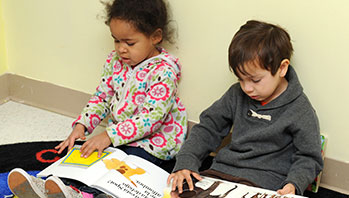- Owl Babies (book)
- brother
- family
- mother
- sister
MA Standards:
Foundational Skills/RF.PK.MA.1.a: Handle books respectfully and appropriately, holding them right-side-up and turning pages one at a time from front to back.
Head Start Outcomes:
Literacy Knowledge/Book Appreciation and Knowledge: Recognizes how books are read, such as front-to-back and one page at a time, and recognizes basic characteristics, such as title, author, and illustrator.
PreK Learning Guidelines:
Health Education 16: Recognize and describe or represent emotions such as happiness, surprise, anger, fear, sadness.
English Language Arts/Language 2: Participate actively in discussions, listen to the ideas of others, and ask and answer relevant questions.
English Language Arts/Reading and Literature 6: Listen to a wide variety of age appropriate literature, read aloud.
One-on-One Reading: Owl Babies #2

© Commonwealth of Massachusetts, Department of Early Education and Care (Jennifer Waddell photographer). All rights reserved.
Read aloud Owl Babies by Martin Waddell to individuals or small groups. Point to the title, author, and illustrator as you introduce the book.
Ask children to name the animals on the cover. Encourage them to tell what role each owl has in the family (brother, sister, mother).
Display illustrations or real objects to help children understand the meaning of unfamiliar words related to the setting of the book such as tree, twigs, branch, leaves, woods, and hunting.
Use facial expressions and excited motions to help children understand how happy the owl babies are when their mother returns. Ask, How do you know the owl babies are happy? (They flapped, danced, bounced up and down)
- Encourage children to make connections between the story and their own lives. Ask, Can you think of a time when your mom or dad or brother or sister was gone? How did it make you feel? What did you do when he/she came back?
English Language Learners: Help children grasp the meaning of what it is to “feel happy.” Provide photographs of people showing happy emotions and have children mimic the emotions. Discuss feeling happy and explain that when you feel happy, you feel good inside. Ask children to share a time they felt happy and “good inside.”
